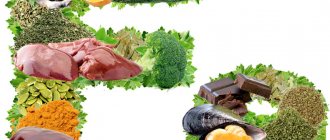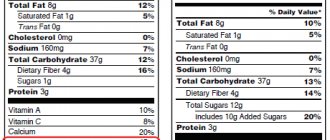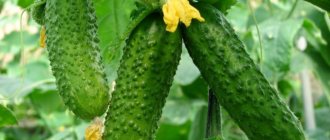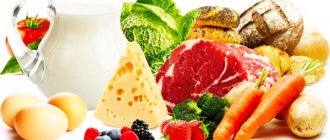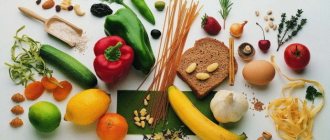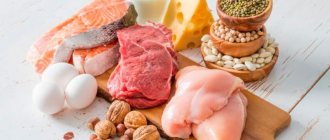The role of fiber in the human body
Dietary fiber belongs to the group of complex carbohydrates - non-starchy polysaccharides that can increase in size when released into liquid. They are the main nutrient medium for beneficial bacteria and help restore intestinal microflora.
Plant fibers have many beneficial properties and perform the following functions (more at nih.gov):
- facilitate the movement of food through the intestines;
- stimulate the flow of bile and prevent the formation of gallstones;
- remove toxins, waste and decay products from the body;
- reduce the level of “bad” cholesterol;
- cause a feeling of satiety;
- reduce sugar absorption;
- improve intestinal motility;
- stabilize the functioning of the excretory system.
Regular consumption of foods with fiber reduces the risk of developing cardiovascular diseases and diabetes, and prevents colon cancer. Thanks to the ability of plant fibers to act on fat deposits, the intestines are cleansed and weight is reduced (links to nih.gov and ncbi.nlm.nih.gov).
The main beneficial properties of beets for the body
Beets and beet juice have many health benefits, especially for heart health and overall fitness.
Beets lower blood pressure
Hypertension is a condition characterized by excessively high blood pressure, which is dangerous due to potential damage to the heart and blood vessels. Persistent symptoms of high blood pressure can become a serious risk factor for the development of cardiovascular diseases and death from them. This risk can be reduced by eating a nutritious diet that includes foods that contain large amounts of inorganic nitrates. This will help establish optimal blood pressure levels and increase the formation of nitric oxide in the body.
Studies have shown that beets or beet juice can reduce blood pressure by up to 10 mm per hour within a few hours (, ).
Scientists attribute this beneficial property of beets to the body by increasing levels of nitric oxide, a molecule that causes blood vessels to relax and dilate ().
Beets are good for people with hypertension, as they can lower blood pressure, which will reduce the risk of heart disease and a number of other diseases.
Increasing the effectiveness of sports activities
Repeated studies have shown that nitrates have an effect on the body during physical activity. They can increase physical performance, especially during high-intensity strength and endurance exercise.
Nitrates have been found to reduce the amount of oxygen consumed by cells during exercise. Nitrates affect mitochondria - cellular particles responsible for energy production (). Beets (or beet juice) are often used for this purpose due to their high inorganic nitrate content.
Consumption of beets can improve the results of aerobic exercise: running and cycling, increase the body's endurance level, improve the use of oxygen by cells and lead to increased efficiency in sports in general ().
Eating beets can optimize the use of oxygen by the body's cells, which will increase endurance and lead to increased performance in physical exercise.
Types of fiber and daily requirement
There are 2 types of fiber - soluble and insoluble. Depending on their ability to swell in water, each of them performs its own beneficial functions for improving intestinal function, which we will discuss below.
Water-soluble fibers
Water-soluble fiber contains a minimal amount of calories, quickly saturates the body and delays the absorption of carbohydrates and fats. This reduces blood sugar levels and the need for insulin production, which prevents excess weight gain.
The benefits of fiber for weight loss
Products rich in water-soluble fiber maintain the level of beneficial intestinal microflora and help destroy pathogenic microorganisms.
Read useful: How does psyllium promote weight loss?
Insoluble fiber
Insoluble fiber makes it easier for food to move through the digestive tract and increases waste volume. Accelerated elimination of toxins and waste improves peristalsis, prevents constipation and reduces the risk of developing hemorrhoids.
Wheat bran is a source of insoluble fiber
By consuming this type of fiber, the level of bad cholesterol and the risk of gallstones are reduced, metabolic processes are normalized, and the intestinal walls are cleansed. As a result, microflora is formed that suppresses the development of harmful bacteria and fungi.
Daily consumption rate
Recommended daily fiber requirement, depending on age:
- children: from 7 months to 3 years - 19 g;
- from 3 to 9 years - 25 g;
- from 10 to 18 years - up to 35 g;
- women - 25 g;
In diabetes mellitus, the need for the substance increases to 40 g daily. Older people need less fiber: 21 g is enough for women, 30 g
What is fiber?
Dietary fiber, also known as fiber, is a food component that is not digested by stomach enzymes. Namely, the shells and pulp of plants - grains, legumes, vegetables, fruits and berries. It is not found in dairy products, eggs, fish, meat; fiber is contained in products of exclusively plant origin. But even different fiber-rich foods contain different types of fiber, which have different effects on the body. And we need all of them.
If we briefly talk about how exactly fiber is useful for weight loss, then in the stomach it absorbs gastric juice, the volume increases and saturation occurs earlier, which helps a person not to overeat.
The recommended daily fiber intake is 25 g for women and 38 g for men. However, most people only eat about half the amount, or a maximum of 15-17 grams of fiber per day. Fortunately, increasing your intake of valuable dietary fiber is quite simple - try including healthy foods containing fiber in your diet. There are 20 of them ahead.
Tables of fiber content in foods
To support intestinal health, you need to adhere to proper nutrition and introduce foods with plant fiber into your diet. Most fiber is found in vegetables, fruits and grains.
Grains and cereals
A high concentration of fiber is found in whole, unprocessed cereals. This product is easy to prepare - just cook the porridge and add spices.
Oatmeal can relieve inflammation of the intestinal mucosa, barley creates a feeling of fullness, millet normalizes metabolic processes.
| Product | Concentration in g per 100 g |
| Buckwheat | 10,8 |
| Oat groats | 2,8 |
| Millet cereal | 2,7 |
| Pearl barley | 2,0 |
| Rice cereal | 1,4 |
| Barley grits | 1,4 |
A good source of plant fiber is whole grain bread. One piece of the product contains 1–2 g of fiber, depending on the variety.
| Product | Concentration in g per 100 g |
| Wheat bran | 12,0 |
| Oats | 10,7 |
| Brown rice | 9,0 |
| Popcorn | 3,9 |
| Boiled corn | 3,1 |
| Oatmeal "Hercules" | 3,1 |
| Bran bread | 2,2 |
| Rye bread | 1,0 |
| Millet | 0,7 |
| Wheat bread | 0,2 |
To obtain maximum benefits, it is recommended to add nuts, seeds, berries and pieces of fruit to porridge.
Vegetables, greens and legumes
Vegetables are valuable sources of both water-soluble and insoluble fiber. Regular consumption of broccoli, onions and carrots allows you not only to increase the amount of fiber, but also to obtain many useful microelements.
| Product | Concentration in g per 100 g |
| Broccoli | 3,3 |
| Brussels sprouts | 3,0 |
| Bulb onions | 3,0 |
| Carrot | 3,0 |
| Horseradish | 2,8 |
| Cauliflower | 2,1 |
| Beet | 2,1 |
| White cabbage | 2,0 |
| Radish | 1,8 |
| Radish | 1,5 |
| Turnip | 1,5 |
| Eggplant | 1,3 |
| Tomatoes | 1,2 |
| Pumpkin | 1,2 |
| Potato | 1,1 |
| Bell pepper | 1,1 |
| Cucumber | 0,7 |
| Zucchini | 0,4 |
Experts recommend introducing salads of fresh vegetables and herbs into your daily diet, to which you can add seeds.
| Product | Concentration in g per 100 g |
| Fennel | 4,3 |
| Spinach | 2,7 |
| Dill | 2,6 |
| Green onions | 2,1 |
| Lettuce with dense leaves | 2,1 |
| Parsley | 1,8 |
| Celery leaves | 1,4 |
| Asparagus | 1,3 |
| Green salad | 0,5 |
Legumes are a valuable source of fiber and protein. For vegetarians, beans, peas and lentils are a good alternative to meat products.
| Product | Concentration in g per 100 g |
| Green pea | 6,0 |
| Beans | 3,7 |
| Lentils | 3,7 |
Read the blog: What are the benefits of apple pectin? Top 5 Reasons to Take a Supplement
Fruits and berries
Fiber is found in almost all berries, especially raspberries, rose hips and currants. They can be used as a healthy snack or added to desserts and cereals.
| Product | Concentration in g per 100 g |
| Dried figs | 5,3 |
| Raspberries | 5,1 |
| Sea buckthorn | 4,7 |
| Strawberries | 4,0 |
| Rose hip | 4,0 |
| Grape | 3,3 |
| Raisin | 3,2 |
| Prunes | 3,2 |
| Black currant | 3,0 |
| Chokeberry | 2,7 |
| Red Ribes | 2,5 |
| Gooseberry | 2,2 |
| Blueberry | 2,2 |
| Blackberry | 2,0 |
| Cranberry | 2,0 |
| Cowberry | 1,6 |
| Cherry | 1,5 |
Heat treatment affects fiber concentration. Freshly squeezed juice with pulp contains a small amount of fiber. Therefore, fruits are recommended to be consumed fresh and not peeled. In winter, you can limit yourself to dried fruits.
| Product | Concentration in g per 100 g |
| Apples | 4,1 |
| Dates | 3,6 |
| Dried apricot | 3,5 |
| Dried apricots | 3,2 |
| Pomegranate | 2,5 |
| Peaches | 2,5 |
| Orange | 2,4 |
| Plum | 1,4 |
| Lemon | 1,3 |
| Fresh apricot | 0,8 |
| Banana | 0,8 |
| Mandarin | 0,8 |
| Grapefruit | 0,7 |
| Pear | 0,6 |
| Melon | 0,6 |
| Watermelon | 0,5 |
Nuts and seeds
Peanuts, almonds and chia seeds contain the most fiber. They can be added to desserts, cereals and salads or used as a healthy snack.
| Product | Concentration in g per 100 g |
| Chia seeds | 34,4 |
| Pumpkin seeds | 18,0 |
| Sunflower seeds | 14,3 |
| Peanut | 9,0 |
| Almond | 9,0 |
| Walnut | 7,8 |
| Hazelnut | 6,1 |
| Hazelnut | 6,0 |
| Psyllium seed husk | 4,0 |
Nuts are a high-calorie food that, if consumed in excessive quantities, can cause digestive upset. To maintain health, it is enough to eat 25 g per day.
Nutritional value
Oats are one of the healthiest grains. In addition to being gluten-free, it is also extremely high in vitamins, minerals, fiber and antioxidants.
In addition, rolled oats are known as porridge, extremely rich in useful components. The product earned this fame thanks to manganese, selenium, phosphorus, magnesium, zinc, vitamin E, carotenoids and flavonoids included in its composition. Manganese, for example, is important for healthy growth, development and metabolism, phosphorus is essential for bone health, copper is considered good for the heart, and iron prevents anemia. You can also talk for a long time about the benefits of selenium, since it is an important antioxidant on which immunity and the ability to resist cancer depend.
Hercules has a reputation as a porridge for helping reduce weight and blood sugar, preventing heart disease and blood clots, among many other health benefits [3][5].
Nutritional value per 100 g
| Calorie content | 362 kcal |
| Squirrels | 11.9 g |
| Fats | 6.9 g |
| Carbohydrates | 69.5 g |
| Vitamin A | 772 mcg |
| Vitamin E | 0.51 mg |
| Vitamin K | 1.9 mcg |
| Vitamin B1 | 0.45 mg |
| Vitamin B2 | 0.05 mg |
| Vitamin B3 | 1.03 mg |
| Vitamin B5 | 1.2 mg |
| Vitamin B6 | 0.08 mg |
| Folic acid | 32 mcg |
| Kholin | 27.7 mg |
| Calcium | 351 mg |
| Iron | 24.72 mg |
| Magnesium | 128 mg |
| Phosphorus | 423 mg |
| Potassium | 366 mg |
| Sodium | 220 mg |
| Zinc | 2.51 mg |
| Copper | 0.36 mg |
| Manganese | 3.39 mg |
| Selenium | 23.2 mg |
The dangers of deficiency and excess fiber
A lack of fiber in the diet increases the risk of developing pathological processes in the intestines and a number of chronic diseases:
- decreased integrity of the intestinal epithelium;
- a state of excessive appetite and constant feeling of hunger, which leads to weight gain;
- development of osteoarthritis of the knee joint;
- impaired intestinal motility, which leads to dysbiosis;
- decreased immunity;
- exacerbation of gastrointestinal diseases.
Fiber deficiency worsens the functioning of the gastrointestinal tract.
Excessive consumption of foods rich in plant fiber is no less dangerous.
Consequences of excess fiber:
- discomfort in the stomach and increased gas formation;
- bloating;
- diarrhea;
- imbalance of microelements and other beneficial substances.
Eating more than 60 grams of dietary fiber per day can cause intestinal blockage and cause dehydration.
Oatmeal infusion to cleanse the body
Another name for this product is oat milk. It's not difficult to prepare. To do this, you will have to pour about a third of a glass of oatmeal with boiled water (cooled). Let the mixture sit (overnight), then strain. Traditional healers advise drinking oat milk daily on an empty stomach with a small amount of honey. They say that this infusion has incredible healing properties, removes toxins, and instead enriches the body with many useful substances.
Best fiber on iHerb
The daily fiber intake is 30 g, which is about 2 kg of vegetables, grains or fruits. It's not easy to eat that much plant food. In addition, excessive consumption of nuts and other high-calorie foods can cause digestive disorders.
It is easier to compensate for dietary fiber deficiency with the help of natural supplements from the iHerb website. Among the advantages of the online store are high quality drugs, affordable prices, no markup for intermediary services and fast delivery to Russia and the CIS countries from the USA in 7-10 days.
Whole Psyllium Hull Now Foods
A dietary supplement from the Now Foods brand to support the digestive system is produced in cans of 340, 454 and 680 g. In 2 tbsp. l. contains 6 g of soluble fiber, 1 g of insoluble fiber, 1.7 mg of iron and 97 mg of potassium.
Instructions for use: 1-2 tbsp. l. Dilute the powder in a glass of water and drink. During the day, be sure to increase the amount of fluid consumed. The price on the iHerb website is $7.
Now Foods Whole Psyllium Hull
Oatmeal for breakfast: the right recipe
As already noted, oatmeal can be consumed in different forms, but the most popular is porridge for breakfast. For the simplest way to prepare breakfast, you will need half a glass of rolled oats, a glass of milk or water, and a pinch of salt.
Mix the ingredients in a saucepan and bring to a boil, then reduce the heat and cook the porridge until soft. Additional ingredients will help make oatmeal more tasty and nutritious. This could be cinnamon, fruit, nuts, seeds or yogurt.
In addition, rolled oats are often used for baking bread, delicious oatmeal cookies and making muesli.
Possible harm and contraindications
Contraindications to taking fiber:
- inflammatory diseases of the gastrointestinal tract and irritable bowel syndrome (only as prescribed by a doctor);
- infants up to 5-6 months.
When using fiber supplements, you must strictly adhere to the drinking regime. Lack of fluid can worsen constipation and cause digestive disorders.
Fiber is a vital element of proper nutrition. It has a calming effect on the intestines and normalizes the function of the digestive system. And how do you make up for the fiber deficiency, share it in the comments.
Benefits in cosmetology
Importance for skin
It is no coincidence that oat extract is included in many skin care products. Also, homemade cosmetics are rarely complete without an important component - oatmeal.
Scientists have determined that oatmeal has a protective effect on the skin, relieves itching and irritation caused by various skin diseases. Experience shows that oatmeal is an excellent cure for eczema. In addition, rolled oats help moisturize the skin and protect against potential irritants, and thanks to its rich mineral and vitamin composition, it nourishes and improves the condition of the epidermis.
14-20: Fruits and berries
| The product's name | Fiber content per 100g | Percentage of daily requirement |
| Apricot | 2.1 g | 7% |
| Avocado | 6.7 g | 22% |
| Quince | 3.6 g | 12% |
| Cherry plum | 1.8 g | 6% |
| A pineapple | 1.2 g | 4% |
| Orange | 2.2 g | 7% |
| Watermelon | 0.4 g | 1% |
| Banana | 1.7 g | 6% |
| Cowberry | 2.5 g | 8% |
| Grape | 1.6 g | 5% |
| Cherry | 1.8 g | 6% |
| Blueberry | 2.5 g | 8% |
| Pomegranate | 0.9 g | 3% |
| Grapefruit | 1.8 g | 6% |
| Pear | 2.8 g | 9% |
| Dried pear | 6 g | 20% |
| Durian | 3.8 g | 13% |
| Melon | 0.9 g | 3% |
| Blackberry | 2.9 g | 10% |
| Strawberries | 2.2 g | 7% |
| Raisin | 9.6 g | 32% |
| Fresh figs | 2.5 g | 8% |
| Dried figs | 18.2 g | 61% |
| Kiwi | 3.8 g | 13% |
| Cranberry | 3.3 g | 11% |
| Gooseberry | 3.4 g | 11% |
| Dried apricots | 18 g | 60% |
| Lemon | 2 g | 7% |
| Raspberries | 3.7 g | 12% |
| Mango | 1.6 g | 5% |
| Mandarin | 1.9 g | 6% |
| Cloudberry | 6.3 g | 21% |
| Nectarine | 1.7 g | 6% |
| Sea buckthorn | 2 g | 7% |
| Papaya | 1.7 g | 6% |
| Peach | 2.1 g | 7% |
| Dried peach | 14.9 g | 50% |
| Pomelo | 1 g | 3% |
| Red rowan | 5.4 g | 18% |
| Rowan chokeberry | 4.1 g | 14% |
| Plum | 1.5 g | 5% |
| White currant | 3.4 g | 11% |
| Red currants | 3.4 g | 11% |
| Black currant | 4.8 g | 16% |
| Dried apricots | 17.6 g | 59% |
| Feijoa | 6.4 g | 21% |
| Dates | 6 g | 20% |
| Persimmon | 1.6 g | 5% |
| Cherries | 1.1 g | 4% |
| Blueberry | 3.1 g | 10% |
| Prunes | 9 g | 30% |
| Rose hip | 10.8 g | 36% |
| Apples | 1.8 g | 6% |
| Dried apples | 14.9 g | 50% |
Significant amounts of dietary fiber can be obtained from most fruits and berries that grow on all continents of the globe. Some representatives are leaders in dietary fiber content.
Avocado (9.2%)
Fiber: 9.2 grams per 100 grams or 18.4 grams per medium-sized avocado.
The fruit contains over 20 vitamins and minerals. Particularly important: folic and ascorbic acids, potassium, copper, tocopherol
Important importance is given to polyunsaturated fats, which occupy up to 30% of the volume of the fetus
Avocado helps reduce total cholesterol and bring its individual fractions to proper values, prevents the development of diabetes mellitus and atherosclerosis of large arteries.
Pear (5.5%)
Pear goes well with any desserts; it contains a lot of fructose (it does not require insulin for absorption), folic acid, vitamins C and A.
Pear is recommended for consumption in the presence of various diseases of the pancreas; it has a beneficial effect on the general condition of obesity and diabetes.
Apple (5.4%)
Fiber: 5.4 grams per 100 grams or 9.72 grams per medium-sized apple.
It is recommended to consume the fruit with the peel, since it contains most of the dietary fiber.
Systematic addition of apples to the diet has a beneficial effect on the health of the digestive system and helps prevent the development of atherosclerosis and cancer.
Raspberry (4.0%)
Fiber: 4.0 grams per 100 grams.
Adding fresh raspberries to various salads prevents the appearance of malignant tumors and improves the health of the skin.
Fiber: 3.4 grams per 100 grams.
Orange (3.4%)
Fiber: 3.4 grams per 100 grams or 5.1 grams per medium-sized orange.
Orange is a unique and extremely healthy fruit. It contains: vitamins (B1, B2, B5, B5, C, PP, A), micro- and macroelements (potassium, calcium, magnesium, iron, phosphorus and sodium).
The product accelerates the motor activity of the digestive tract, prevents the processes of fermentation and decay of chyme, helps strengthen general immunity and reduce cholesterol in the blood plasma. Consumption of orange reduces the risk of sudden vascular mortality by 1.5 times.
Banana (2.6%)
Bananas contain a lot of vitamin C, potassium and magnesium.
It is recommended to replace snacks with this fruit or add it to fruit salads. Banana improves neuromuscular transmission of impulses and improves blood supply to the brain.
Raspberry (4.0%)
The berry has a significant range of antioxidant components. Raspberries contain a large amount of vitamins C and K.
